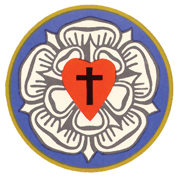|

| |
The Lutheran church
is nearly 600 years old. Martin Luther (1483-1546) was an Augustinian
monk and an ordained priest in the Roman Catholic church who lived
in Germany. While pursuing a Doctor of Theology degree he discovered
significant differences between what he read in the Bible and the
theology and practices of the church of his day.
On October 31, 1517, he posted a challenge on the church door
at Wittenberg University to debate 95 theological issues. Luther's
hope was that the church would reform its practice to be more
consistent with the Bible. What started as an academic debate
escalated to a religious war; as a result, there was not a reformation
of the church but a separation. “Lutheran” was a name
applied to Luther and his followers as an insult but they adopted
it as a badge of honor instead.
Lutherans still hold to the basic principles of theology and
practice espoused by Luther, such as:
- We are saved by the grace of God along—not by what
we do;
- Our salvation is through faith alone—we only need to
believe that our sins are forgiven for Christ's sake, who died
to redeem us;
- The Bible is the only norm of doctrine and life—the
only true statement by which teachings and doctrines are to
be judged.
Luther's Small Catechism (which contains basic teachings on the
Ten Commandments, the Apostles' Creed, the Lord's Prayer, Holy
Baptism, and Holy Communion) is still used to introduce people
to the Lutheran faith, as is the more detailed Augsburg Confession.
These and other Lutheran confessional documents are included in
the Book of Concord.
Martin Luther’s Seal |
|
| |
Martin Luther created his seal
while he was a professor at Wittenberg University. The seal was
meant to be “expressive of his theology.” The seal
shows a cross on a heart at the center of a rose. The Messianic
rose symbolizes Christ and is enclosed in a circle that denotes
eternity. This explanation is taken from a letter written to his
friend, Herr Spengler, the town clerk of Nuremberg.
The first thing expressed in my
seal is a cross, black, within the heart, to put me in mind that
faith in Christ crucified saves us. “For with the heart
man believeth unto righteousness.”
Now, although the cross is black, mortified, and intended to
cause pain, yet it does not change the colour of the heart, does
not destroy nature—i.e., does not kill, but keeps alive.
“For the just shall live by faith.”—by faith
in the Saviour.
|
 |
|
| |
But this heart is fixed upon the centre of a white rose, to show
that faith causes joy, consolation, and peace. The rose is white,
not red, because white is the ideal colour of all angels and blessed
spirits.
This rose, moreover, is fixed in a sky-colored ground, to denote
that such joy of faith in the spirit is but an earnest and beginning
of heavenly joy to come, as anticipated and held by hope, though
not yet revealed.
And around this groundbase is a golden ring, to signify that
such bliss in heaven is endless, and more precious than all joys
and treasures, since gold is the best and most precious metal.
Christ, our dear Lord, He will give grace unto eternal life.
Amen,
Martin Luther
Additional information on the history and beliefs of the Lutheran
Church is available on the ELCA
web site. |
|
Return to What We Believe
|

